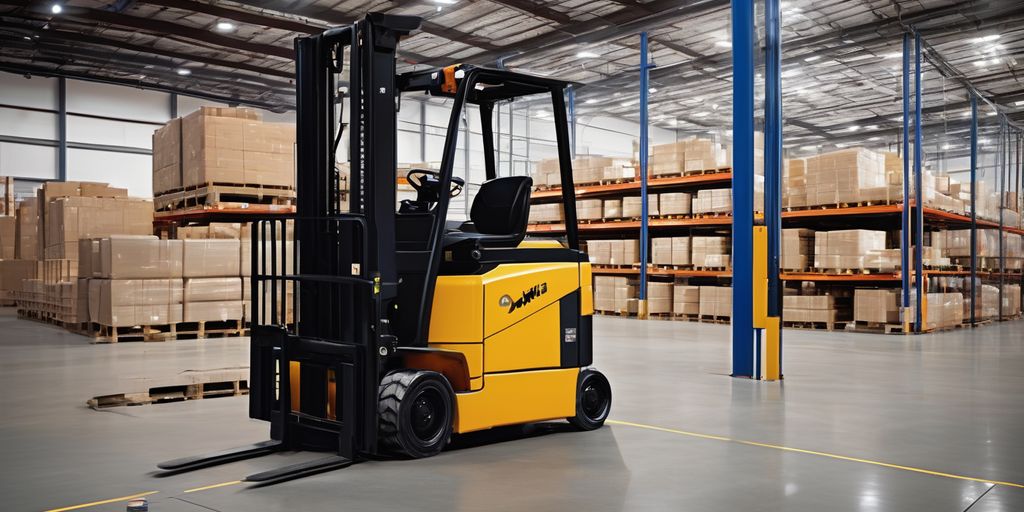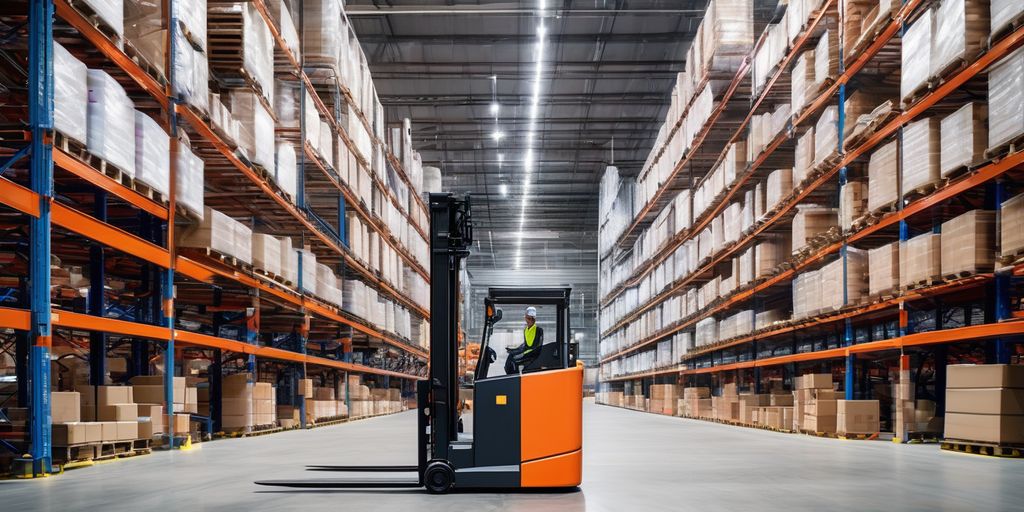Forklift Telematics: Optimizing Fleet Management Through Data — overview
Forklift telematics is revolutionizing the way fleet management is conducted by leveraging data-driven insights. By utilizing devices fitted on forklifts and telematics instruments, critical data is collected and transmitted to a central server. This real-time data allows teams to assess the vehicle’s state, plan maintenance, and identify areas for operational improvement, ultimately optimizing fleet utilization and reducing costs.
Key Takeaways
- Forklift telematics systems use wireless technology to gather and transmit data from individual forklifts to a central management system.
- Real-time data from telematics enables fleet managers to identify inefficiencies, schedule preventive maintenance, and ensure safety compliance.
- Telematics systems enhance operational efficiency by providing real-time tracking, monitoring, and optimized fleet utilization.
- Predictive maintenance facilitated by telematics reduces downtime and extends the lifespan of the forklift fleet.
- Data-driven decision-making enabled by telematics leads to improved productivity, efficiency, and strategic planning.
Understanding Forklift Telematics

Forklift telematics uses wireless technology to collect and transmit data from individual forklifts to a central management system. These systems monitor engine hours, fuel consumption, forklift maintenance alerts, and impact events. This real-time data allows fleet managers to identify operational inefficiencies, schedule preventive maintenance to minimize downtime, and ensure compliance with safety standards.
How Telematics Systems Work
Devices fitted on the forklift, along with a telematics instrument, collect data, and the collected data is sent to, stored, and accessed on a central server. Teams can review and interpret the data to determine the vehicle’s state and use it to plan and preempt maintenance and repairs. With this fleet tracking system, you can save by identifying areas of operational improvement, whether with fuel efficiency or by enhancing driving skills.
Key Components of Forklift Telematics
- Telematics Device: Installed on the forklift to collect data.
- Central Server: Stores and processes the collected data.
- Management Software: Allows teams to review and interpret the data.
Benefits of Implementing Telematics
Telematics has undeniably transformed the way forklift fleets are managed. By providing critical insights into every aspect of fleet operation, from real-time location tracking to behavior monitoring, these systems enable a level of control and optimization that was previously unattainable. The integration of telematics in forklift operations isn’t just a trend; it’s becoming an industry standard for enhancing efficiency, ensuring safety, and promoting cost-effectiveness.
Enhancing Operational Efficiency with Telematics

Telematics systems are pivotal in streamlining operations. They offer real-time tracking and monitoring, leading to optimized utilization of forklift fleets. Here’s how:
Real-Time Tracking and Monitoring
Real-time tracking and monitoring enable fleet managers to have improved visibility into the location and status of each forklift. This technology enables real-time tracking, performance monitoring, and data-driven insights that optimize fleet management. By knowing the exact position and condition of each vehicle, managers can make informed decisions quickly.
Optimizing Fleet Utilization
Telematics systems help in optimizing fleet utilization by providing data on usage patterns. This allows for better scheduling and deployment of forklifts, ensuring that each vehicle is used efficiently. Improved fuel efficiency by decreasing fuel consumption, your business can save money. A significant feature of telematics software is improved visibility into operations, which helps in making data-driven decisions.
Reducing Operational Costs
Implementing a telematics system can lead to significant cost savings:
- Reduced Fuel Consumption: Telematics helps in monitoring and optimizing routes, leading to lower fuel consumption.
- Lower Maintenance Costs: Predictive maintenance reduces the likelihood of major repairs, thereby saving costs.
- Better Asset Management: Understanding usage patterns helps in making informed decisions about fleet expansion or downsizing, optimizing investments.
Industry standard for enhancing efficiency, ensuring safety, and promoting cost-effectiveness. As we move forward, the role of telematics in industrial operations will only become more integral, making it an essential tool for any forward-thinking fleet manager.
Predictive Maintenance and Reduced Downtime

Monitoring Forklift Health
Think of predictive maintenance as a forklift health plan that helps cut down on repair bills through planned maintenance and extend the truck’s useful life. Integration of IoT, AI, and telematics in forklifts is enabling real-time monitoring and predictive maintenance, thereby reducing downtime.
Scheduling Preventive Maintenance
With centralized management, unexpected charges can be minimized, and warranty repairs can be tracked to leverage coverage fully. This proactive approach shifts the focus from reactive repairs to disciplined preventive maintenance, boosting uptime and ensuring consistent service quality across the fleet.
Extending Fleet Lifespan
- AI and Machine Learning
- Predictive Maintenance: AI algorithms could reduce maintenance costs by up to 25% by predicting equipment failures before they occur.
- Route Optimization: Machine learning can improve route efficiency by 15-20%, significantly reducing fuel costs and time on the road.
- Automation in Telematics
- Autonomous Forklifts: Trials suggest that semi-autonomous forklifts could increase operational efficiency by 30% and reduce labor costs by up to 40%.
Merging IoT with the latest Industry 4.0 tech into our material handling equipment is a game-changer for workplaces, ramping up precision.
Improving Safety and Compliance

Safety is a paramount concern in forklift operations, and telematics plays a crucial role in enhancing it. By tracking lift trucks' performance and forklift operators' activities, telematics systems can supplement trainers in assessing skill levels and compliance. This ensures that all safety protocols are strictly followed, reducing the risk of accidents.
Telematics systems provide real-time data on operator behavior, such as speed, braking patterns, and adherence to safety protocols. This data can be used to identify risky behaviors and implement corrective actions.
- Monitoring speed and braking patterns
- Ensuring adherence to safety protocols
- Identifying and addressing risky behaviors
In the event of an accident, telematics systems can provide detailed data on the incident, including the time, location, and impact force. This information is crucial for conducting thorough accident investigations and implementing preventive measures.
| Incident Data | Description |
|---|---|
| Time | Exact time of the accident |
| Location | GPS coordinates of the incident |
| Impact Force | Measured force of the collision |
By leveraging telematics data, companies can significantly improve their safety measures and ensure compliance with industry standards.
Data-Driven Decision Making

Analyzing Operational Data
In the realm of forklift telematics, access to real-time, integrated data from once-disparate information sources allows fleet managers to understand more than just what happened before. This comprehensive data collection provides a holistic view of fleet operations, enabling managers to make informed decisions that enhance efficiency and productivity.
Identifying Areas for Improvement
By leveraging fleet analytics, managers can pinpoint inefficiencies and areas for improvement. This process involves analyzing various data points such as load sensing, task selection, and labor management metrics. The insights gained from this analysis can drive smarter, data-driven decisions for efficient fleet management.
Leveraging Insights for Strategic Planning
Strategically, fleet data management supports data-driven decision-making by providing actionable insights into fleet performance. This enables managers to make strategic decisions, from right-sizing the fleet to optimizing associates for maximum productivity and effectiveness. The integration of big data analytics can further enhance strategic decision-making, potentially increasing fleet utilization rates by up to 25%.
When this data is aggregated across your entire forklift fleet, it provides a holistic view of fleet operations. That said, simply collecting data isn’t sufficient. It's crucial that this data is consolidated and presented in a format that aids decision-makers without overwhelming them. An overload of data can be as problematic as a shortage, potentially obscuring vital insights.
Boosting Productivity and Efficiency

Automated Data Collection
Automated data collection in forklift telematics systems streamlines the process of gathering critical information. This includes data on load weights, travel distances, and operational hours. By automating these tasks, companies can reduce human error and ensure that data is accurate and up-to-date.
Enhancing Operator Performance
Telematics systems provide insights into operator behavior, helping to identify areas for improvement. For instance, data on speed, braking, and acceleration can be used to train operators more effectively. This not only enhances safety but also boosts overall productivity.
Streamlining Workflow
By analyzing operational data, companies can identify bottlenecks and inefficiencies in their processes. This allows for better resource allocation and improved scheduling, ultimately leading to increased productivity. For example, real-time communication and technology integration can significantly enhance operational efficiency.
Maximizing warehouse efficiency with forklift fleet management is crucial for operational productivity. Strategies include real-time communication, maintenance, training, and technology integration for cost savings and asset utilization.
Future Trends in Forklift Telematics

Advancements in Telematics Technology
As technology advances, the capabilities of forklift telemetry systems are expanding rapidly. Predictive maintenance technology uses advanced algorithms to analyze telemetry data and identify potential issues before they cause downtime. This AI-powered analytics tool can also provide deeper insights into your operations, revealing the not-so-obvious areas ripe for optimization.
Integration with Other Systems
The future of forklift telematics will see greater integration with other systems within the warehouse. This includes Warehouse Management Systems (WMS), Enterprise Resource Planning (ERP) systems, and even Internet of Things (IoT) devices. Such integration will enable seamless data flow and more cohesive operational strategies.
The Growing Importance of Data Analytics
Telematics systems can provide real-time data for monitoring forklifts in the warehouse and the data to help streamline operations, enhancing efficiency and productivity. The growing importance of data analytics in forklift telematics cannot be overstated. By leveraging big data, companies can make more informed decisions, identify trends, and optimize their fleet management strategies.
The integration of telematics in forklift operations isn’t just a trend; it’s becoming an industry standard for enhancing efficiency, ensuring safety, and promoting cost-effectiveness.
Conclusion
Forklift telematics has revolutionized fleet management by providing real-time data and insights that drive operational efficiency, safety, and cost-effectiveness. By integrating telematics systems, businesses can monitor engine hours, fuel consumption, and maintenance needs, allowing for predictive maintenance and reduced downtime. The ability to track and analyze forklift usage patterns not only enhances productivity but also extends the lifespan of the equipment. As the industry continues to evolve, the adoption of telematics is becoming an essential strategy for both small-scale firms and large enterprises to optimize their fleet operations and ensure compliance with safety standards. Embracing this technology is a forward-thinking move that promises significant long-term benefits.
Frequently Asked Questions
What is forklift telematics?
Forklift telematics uses wireless technology to collect and transmit data from individual forklifts to a central management system. These systems monitor engine hours, fuel consumption, maintenance alerts, and impact events.
How do telematics systems work?
Devices fitted on the forklift, along with a telematics instrument, collect data and send it to a central server. Teams can review and interpret this data to determine the vehicle’s state and plan maintenance and repairs.
What are the benefits of forklift telematics?
Forklift telematics provide real-time data that allows fleet managers to identify operational inefficiencies, schedule preventive maintenance to minimize downtime, and ensure compliance with safety standards.
How does telematics enhance operational efficiency?
Telematics systems offer real-time tracking and monitoring, leading to optimized utilization of forklift fleets. This helps in reducing operational costs and improving productivity.
What role does telematics play in predictive maintenance?
By monitoring forklift health, telematics aids in predicting maintenance needs, reducing downtime, and extending the lifespan of the fleet.
Why is data-driven decision making important in forklift fleet management?
Access to comprehensive information through telematics allows fleet managers to gather, analyze, and leverage relevant data to reduce expenses while improving productivity for both operators and vehicles.




Leave a comment
This site is protected by hCaptcha and the hCaptcha Privacy Policy and Terms of Service apply.